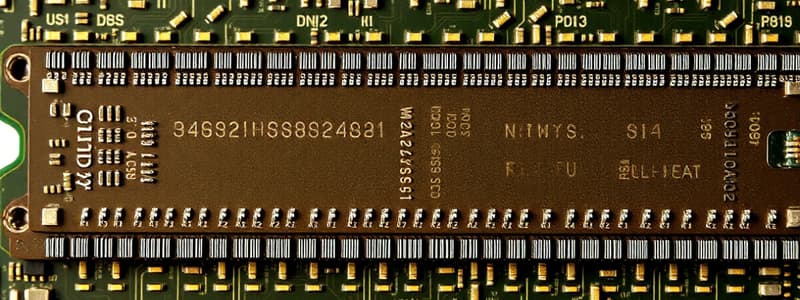Podcast
Questions and Answers
What is the primary purpose of virtual memory?
What is the primary purpose of virtual memory?
- To manage memory fragmentation
- To increase the speed of main memory
- To permanently store files
- To extend RAM by using hard disk space (correct)
Paging divides memory into segments of varying sizes.
Paging divides memory into segments of varying sizes.
False (B)
What is memory fragmentation?
What is memory fragmentation?
Memory fragmentation occurs when memory is not contiguous, making it difficult to load large programs.
When main memory is full, ______ is used as an extension of RAM.
When main memory is full, ______ is used as an extension of RAM.
Match the following memory management concepts to their descriptions:
Match the following memory management concepts to their descriptions:
Flashcards
Main Memory
Main Memory
The primary storage used by a computer, hosting the operating system and applications. Programs are loaded into main memory to run.
Memory Fragmentation
Memory Fragmentation
A situation where memory is not allocated in a contiguous block, making it difficult to load large programs. This happens when memory is used and freed in an unsystematic way.
Paging
Paging
A memory management technique that divides the main memory into fixed-size chunks called pages. It allows programs to be split into pages and loaded into available memory spaces.
Segmentation
Segmentation
Signup and view all the flashcards
Virtual Memory
Virtual Memory
Signup and view all the flashcards
Study Notes
Memory Management
- Main memory is the primary storage used by a computer. It hosts the operating system and applications.
- An application's space in memory can be released when it's closed.
- Memory fragmentation occurs when memory is not contiguous, making it difficult to load large programs.
- Paging and segmentation are two strategies to manage memory more efficiently.
- Paging divides memory into fixed-size blocks called pages. Programs are split into pages.
- While paging offers flexibility, it can lead to inefficiencies when program structures are split across pages.
- Segmentation divides memory into segments of varying sizes. These segments correspond to logical divisions within programs.
- Segmentation allows programs to be loaded even if they are larger than available contiguous memory.
Virtual Memory
- When main memory is full, virtual memory comes into play, utilizing the hard disk as an extension of RAM.
- Virtual memory enables running more programs than available RAM by swapping less frequently used data and instructions to the hard disk.
- This creates the illusion of having considerably more RAM than physical hardware provides.
- Swapping data back and forth between RAM and the hard disk slows down performance.
- This is because the hard disk is much slower than RAM.
Studying That Suits You
Use AI to generate personalized quizzes and flashcards to suit your learning preferences.
Description
Explore the essential concepts of memory management and virtual memory in this quiz. Understand the differences between paging and segmentation, memory fragmentation, and how virtual memory enhances system performance. Test your knowledge on these critical topics in computer science.




